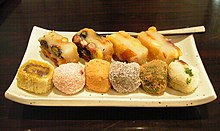 | |
| Alternative names | Rice cake |
|---|---|
| Type | Rice cake |
| Place of origin | Korea |
| Main ingredients | Flour made of various grains, including glutinous or non-glutinous rice |
| Variations | Steamed, pounded, shaped, pan-fried |
| Korean name | |
| Hangul | 떡 |
|---|---|
| Revised Romanization | tteok |
| McCune–Reischauer | ttŏk |
| IPA | [t͈ʌk̚] |
 |
| This article is part of a series on |
| Korean cuisine 한국 요리 조선 료리 |
|---|
Tteok (Korean: 떡) is a general term for Korean rice cakes. They are made with steamed flour of various grains,[1] especially glutinous and non-glutinous rice. Steamed flour can also be pounded, shaped, or pan-fried to make tteok. In some cases, tteok is pounded from cooked grains.
Tteok is eaten not only as a dessert or seasonal delicacy, but also as a meal. It can range from elaborate versions made of various colors, fragrances, and shapes using nuts, fruits, flowers, and namul (herbs/wild greens), to plain white rice tteok used in home cooking. Some common ingredients for many kinds of tteok are red bean, soybean, mung bean, mugwort, pumpkin, chestnut, pine nut, jujube, dried fruits, sesame seeds and oil, and honey.
Tteok is usually shared. Tteok offered to spirits is called boktteok ("good fortune rice cake") and shared with neighbours and relatives. It is also one of the celebratory foods used in banquets, rites, and various festive events. Tteokguk ("rice cake soup") is shared to celebrate Korean New Year and songpyeon is shared on Chuseok, a harvest festival.
- ^ (in Korean) "떡01". Standard Korean Language Dictionary. National Institute of Korean Language. Archived from the original on 2017-10-05. Retrieved 2017-02-24.